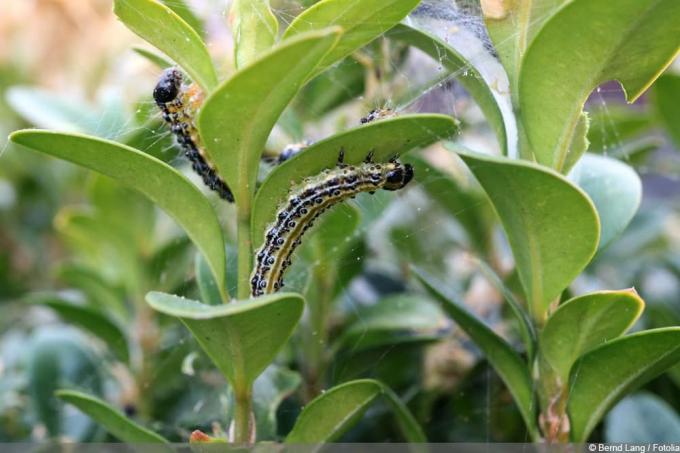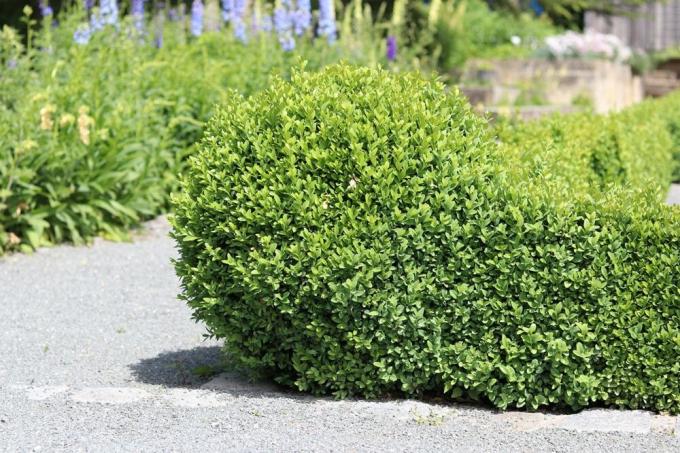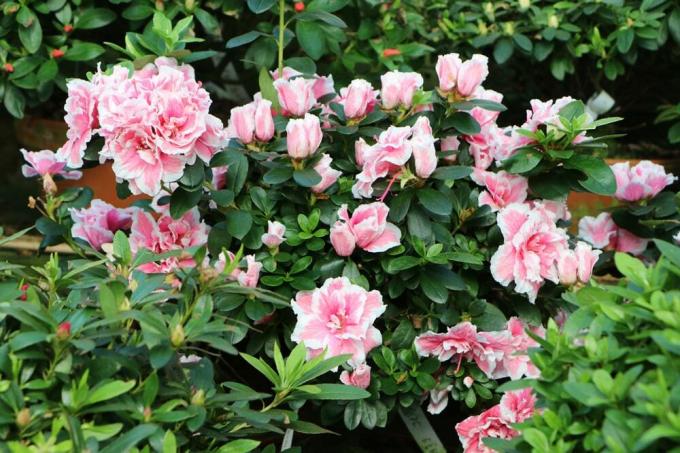

Table of contents
- fungal diseases
- Dieback / boxwood fungus
- boxwood wilt
- boxwood canker
- boxwood rust
- pests
- boxwood spider mite
- boxwood midge
- harmless causes
- Not enough water
- sunburn
- cold
Ideally, the evergreen boxwood has beautiful, green foliage all year round. However, if this turns brown and dries up, the plant should be examined more closely. Because it is not uncommon for these to be symptoms of a fungal disease or pest infestation. We will explain to you how you can identify the cause of the brown discoloration and how to subsequently combat it.
fungal diseases
If the leaves suddenly turn brown and dry up, this can often be traced back to a fungal disease. Which fungus causes the symptoms can usually only be determined on closer inspection. In principle, however, the following applies: As soon as there is a suspicion of a fungal disease, action should be taken immediately!
Dieback / boxwood fungus
The dreaded shoot dieback is caused by a sac fungus called Cylindrocladium buxicola. The fungus is favored by warm, humid weather and is blown onto the shoots and leaves by the wind. A disease is first noticeable in many small white-greyish spore deposits. As a result, orange to brown spots appear on the upper side of the leaf, which grow larger and finally grow together to form a large area. If the fungus is not combated, the fungus will continue to spread. The leaves fall off and the shoots gradually die off. It is therefore advisable to act immediately when symptoms appear:
- Prune boxwood immediately and vigorously
- Cut back into the healthy tissue
- Dispose of cut shoots in household waste
- Rake up and discard fallen leaves
- remove the top layer of soil
A notice:
It is advisable to remove the top layer of soil, as the fungus can easily survive in the soil for several years.
boxwood wilt

The box tree wilt can be traced back to the sac fungus Fusarium buxicola, which mainly affects old box trees. A disease is first noticeable on the leaves, because they become wilted and leathery soft. Dark brown spore deposits can also be seen on the leaves, mostly as small dots. If the fungus continues to spread unhindered, it can also affect the shoots. However, the shoots are usually affected relatively late. If the plant falls ill with boxwood wilt, it is best to proceed as with the boxwood fungus:
- strong pruning into the healthy tissue
- Dispose of fallen and cut leaves in the household waste
- remove the top layer of soil
boxwood canker
Boxwood canker occurs mainly in weakened plants. However, it can also be favored by care errors. Because both drought stress and waterlogging as well as a lack of nutrients and an incorrect pH value promote the occurrence of boxwood canker. If the plant falls ill with boxwood canker, this is first noticeable by twisted and attached leaves. The leaves first turn yellow, later brown and finally fall off. Pink pustules may also appear on the leaves. If the boxwood canker is not treated, the hind tears open or even detaches itself from the wood. Entire branches can also dry out. Again, it is advisable to act quickly:
- Prune the boxwood vigorously
- to the healthy tissue
- Discard diseased plant parts
- also the fall foliage!
boxwood rust
Another dangerous fungus for boxwood is the rust fungus Puccinia buxi. This primarily affects older and weakened box trees and settles on their leaves in spring. The fungus penetrates further into the tissue, so that rusty-brown spore deposits become noticeable on the leaves in autumn. Boxwood rust should also be combated immediately:
- cut off affected shoots
- dispose of in household waste
- Use fungicide if infestation is severe
pests

Brown and dry leaves are not always a sign of fungal diseases, because the symptoms can also occur with a pest infestation. However, the unwanted pests can usually be fought relatively easily and, above all, reliably.
boxwood spider mite
The boxwood spider mite prefers a dry and warm climate, which is why an infestation usually occurs in summer. This can initially be recognized by fine, yellowish stripes and spots on the leaves. The foliage then turns bronze to brown and dries up. If the infestation is not combated, it will ultimately lead to leaf drop. However, boxwood spider mites can usually be effectively combated as follows:
- use oily agents
- this destroys the eggs
- Spider mite remedy in spring
- natural enemies: predatory mites
boxwood midge
In the case of an infestation with the boxwood gall midge, the symptoms are about the same as in the case of an infestation with the boxwood spider mite. The spots that appear are also yellowish, but larger and less sharp. In addition, the underside of the leaf is swollen like bubbles. If only individual leaves are affected, this is usually not a cause for concern. The situation is different, however, if the infestation spreads. Because this can lead to massive leaf loss and thus to the weakening of the plant. In the case of an infestation with the boxwood gall midge, the best way to proceed is as follows:
- remove individual leaves in spring
- before the larvae hatch
- Cut back the boxwood if the infestation is severe
A notice:
The larvae of the boxwood midge provide a welcome meal for many songbirds. Tits in particular are attracted to them and could cause additional damage to the boxwood.
harmless causes

Brown and dry leaves are not always a cause for concern. Because it is not uncommon for these to be natural reactions of the plant or care errors. Intervention is not always necessary in these cases, because the brown leaves usually turn green again by themselves.
Not enough water
Adequate water supply is one of the basic requirements for healthy growth of the boxwood. However, if the plant is in a particularly bright location and it has grown too densely, water absorption can be affected. Because in this case, the rain can not only penetrate the dense foliage into the ground. The boxwood does not absorb enough water, which in turn turns the leaves brown. However, this can usually be remedied with the right watering behavior:
- water regularly
- even in the rain!
- Special fertilizer in spring and summer
- this strengthens the boxwood
sunburn
It is not uncommon for entire sections of the bush to turn brown in the same direction. The south to south-east side is usually affected. If there are no other symptoms, this can usually be traced back to sunburn. Especially when the leaves are covered with hoarfrost and suddenly get a lot of sun.
cold
If the boxwood gets yellowish or brownish leaves in winter, this is usually not a cause for concern. Because this is a natural reaction of the plant, which wants to protect itself from the low temperatures. In this case, there is nothing to do because the leaves will turn green again by themselves.
 garden editorial
garden editorial I write about everything that interests me in my garden.
Learn more about shrubs and woody plants

17 flowering hardy plants May to October
Many plants only show their full splendor for a short time. But there are also types and varieties with a particularly long flowering period from May to October, sometimes even longer. We present 17 flowering hardy plants.

25 hardy and evergreen ornamental trees
Ornamental trees are among the most popular plants in the garden. They have a decorative effect and set special accents in the green oasis. If you are tired of the gray of the cold season, you can plant trees that are hardy and evergreen.

Is barberry poisonous? | What is to be considered?
With their dense growth, numerous thorns and evergreen foliage, barberries are one of the most popular types of plants for a hedge in the garden. Before cultivating the sour thorn family (Berberidaceae), many ask themselves whether the plant is poisonous.

Azalea location: 6 important criteria
Azaleas are a flowering addition to the garden or living room, as long as they are in the right location. In the following guide to azaleas, we will tell you what to look out for.

How fast does a rhododendron grow? | Information about growth
How fast a rhododendron grows depends on various factors, including the variety, location and care. Growth can be accelerated under optimal conditions, while deficiencies lead to stunted growth.

Butterfly bush: the ideal location | Buddleia
The uncomplicated, easy-care and robust butterfly bush is suitable in the garden for borders, a flowering hedge or as a solitaire. Dwarf summer lilacs are ideal for pot culture. Buddleia bloom from June to October and are a magnet for many butterflies.


